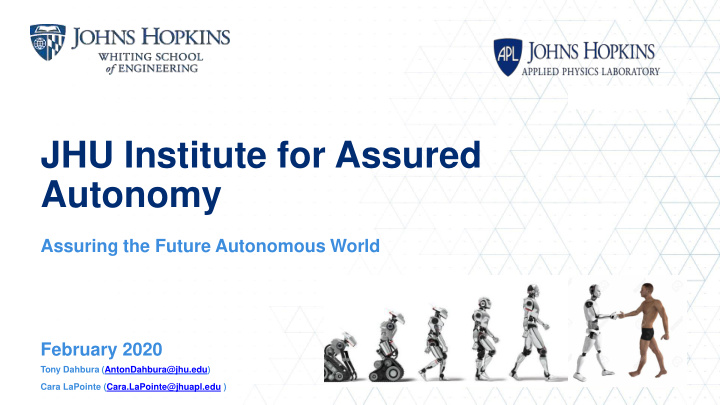



JHU Institute for Assured Autonomy Assuring the Future Autonomous World February 2020 Tony Dahbura (AntonDahbura@jhu.edu) Cara LaPointe (Cara.LaPointe@jhuapl.edu )
IAA Strategic Approach Dissemination Partnerships Internal and Research Produce results that have Sponsored challenges impact on AA Research Testbeds, Tools, AA Roadmap Methodologies. Apply test results on real world applications Identify knowledge Translation Flagship Projects gaps Partnerships Grow Resour ources ces
IAA Status and Current Activities • JHU President Ron Daniels has committed $25M over the next five years for research, faculty slots and facilities- largest commitment of its kind; • Spring Assured Autonomy workshop drew 150 participants from WSE and APL; • First round of internal funding has resulted in 48 pre-proposals and 23 proposals of which 10 are being funded for $3.2M (two years); • BDP Executive Director search is underway; • Candidates for faculty slots are being considered; • Space reserved in the Stieff Silver Building for IAA headquarters. 4
5 Autonomous System Lifecycle Specification, Normal Operation Design, & Operation Under Attack Test 8- Regression Analysis for 7-White Box/Black Box Monitoring of 11- Adversarial ML for Visual Autonomous Performance Autonomous System Operation Object Recognition Improvement 23- Adversarial Learning Using 12- Methods to Avoid Bias and Data 9- Assured Resource Managers for Learning Agents Leaks in DL Systems Assured Autonomy (Airspace Ops) 13- Safety and Performance Verification for ML Systems 3- Human-System Interactions (human intent) 21- Explainable AI Policy & Governance 5- Assured Autonomy Policy Development Formal Methodology 13 February 2020
BIAS AND PRIVACY ATTACKS IN AI FOR HEALTHCARE AND AUTOMOTIVE SYSTEMS (Burlina, Cao) • Deep learning algorithms can leak private information and may be gender/race/disease biased. • The proposed work develops algorithms to address bias as well as approaches to assess possible risks in existing algorithms for privacy / membership attacks, and proposes ways to effectively defend against such privacy attacks. • The investigators use: 1. directed data augmentation using synthetic data produced from deep generative models to address both bias and privacy challenges; and 2. identity-obfuscation pre-processing to reduce the risk of membership and related attacks on privacy while maintaining the performance of diagnostic models. 6
PHYSICAL DOMAIN ADVERSARIAL MACHINE LEARNING FOR VISUAL OBJECT RECOGNITION (Yuille, Cao, Burlina) • Addresses adversarial attack and defense techniques for machine learning and deep learning applied to visual object recognition, specifically including methods that implement patch and occlusion attacks. • The objective is to establish an ecosystem composed of adversarial machine learning (AML) attack/defense algorithms as well as a testbed specifically for evaluating non-differentiable patch- and occlusion-based physical AML algorithms. • The new models contain explicit representations of object parts and detect the objects if a significant number of these parts have been detected in plausible spatial configurations. 7
RISK-SENSITIVE ADVERSARIAL LEARNING FOR AUTONOMOUS SYSTEMS (Llorens, Arora) • Deep reinforcement learning (DRL) formulations have several shortcomings, including a general lack of robustness when employed in dynamic and uncertain environments. • The researchers develop an adversarial learning framework for developing robust, risk-sensitive DRL agents. • DRL typically relies heavily on simulation due to the impracticality of replicating large numbers of diverse trials in the real world; however, simulated environments invariably differ from their real-world counterparts. • The researchers pose the learning problem as a competition between an agent that seeks to avoid undesirable outcomes and a parameterized environment that dynamically reconfigures itself in order to cause them. • Experimentation using application-inspired agents, simulation environments and a proof-of-concept hardware demonstration. 8
IAA Research in Assured Transportation https://teslamotorsclub.com/tmc/threads/airbus-vision-of-an-electric-air-land-taxi.87448/ https://goo.gl/images/CRGPaJ 12
IAA Research in Assured Public Safety and Security • Top-level goals include: - Create a cyber-secure central system for monitoring and managing a large presence of campus IoT devices - Partner with government, industry and academia to facilitate the development of assured autonomous devices for augmenting the IoT network and building additional safety services onto the network to enhance campus-based smart functions & services - Increase the level of trustworthiness in individual technologies and integration of these technologies into systems to facilitate the deployment of research prototypes without the fear that the technology is likely to be misused or be unavailable when truly needed https://goo.gl/images/kdNQWV https://goo.gl/images/MxGk3w 14
IAA Research in Assured Health Systems • Top-level goals include: - Partner across JHU to evaluate existing and emerging health technologies that provide trustworthy autonomy and eliminate cyber-related harm to patients and other healthcare stakeholders - Develop standards of practice as well as implementation frameworks and be seen as the world’s preeminent trustworthy autonomy and cyber- safe healthcare institution - Partner with government, industry, and academia for the development of assured autonomous medical systems, leveraging JHUs medical research labs for the assurance of legacy and next-gen intelligent medical systems - Explore human-machine teaming for advanced, efficient, reliable, and trusted medical and health services and share knowledge of how to achieve this with the world https://goo.gl/images/uiLe77 16
Questions? Thank you! 17
Recommend
More recommend